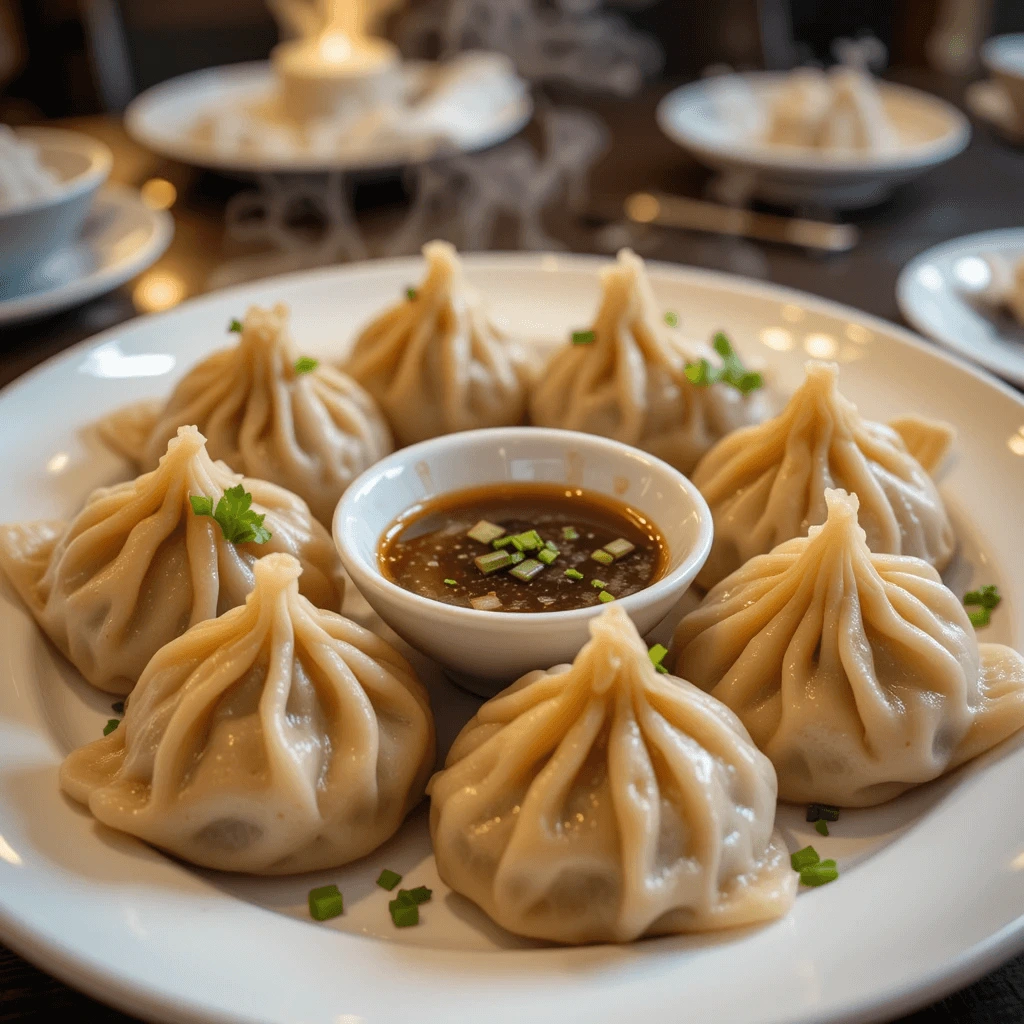Introduction
Print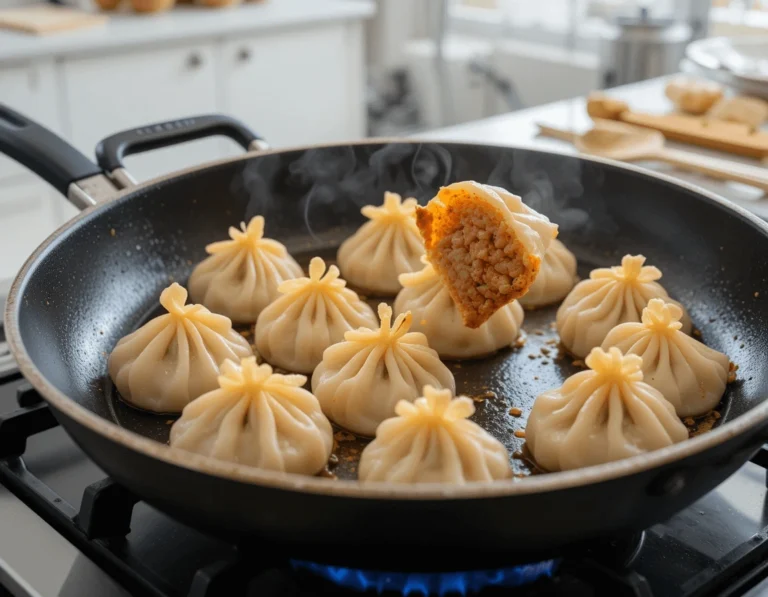
Pork Dumplings (Jiaozi): The Ultimate Guide to History, Filling, and Cooking Tips
These Pork Dumplings (Jiaozi) are the perfect homemade comfort food, filled with savory pork and fresh vegetables, wrapped in delicate dough, and cooked to perfection. Whether steamed, boiled, or pan-fried, Jiaozi is a delightful and versatile dish that can be enjoyed as a snack, appetizer, or main course. With the option to customize the filling to your taste, Pork Dumplings (Jiaozi) are ideal for family gatherings, festive occasions, or simple weeknight dinners.
- Total Time: 55 minutes
- Yield: 24 dumplings 1x
Ingredients
For the Dumpling Filling:
1 pound ground pork
1 cup cabbage, finely chopped
1/4 cup green onions, chopped
1 tablespoon ginger, minced
1 tablespoon garlic, minced
2 tablespoons soy sauce
1 tablespoon sesame oil
1/2 teaspoon salt
1/2 teaspoon pepper
For the Dough:
2 cups all-purpose flour
3/4 cup boiling water
1/2 teaspoon salt
For Cooking:
Oil for pan-frying (optional, if frying)
Water for boiling or steaming
Instructions
Prepare the Dough:
In a bowl, combine the flour and salt.
Gradually add the boiling water while stirring with a spoon until the dough begins to come together.
Knead the dough on a floured surface for about 10 minutes until smooth.
Cover the dough with a damp towel and let it rest for 30 minutes.
Prepare the Filling:
In a large bowl, mix together the ground pork, finely chopped cabbage, green onions, ginger, garlic, soy sauce, sesame oil, salt, and pepper.
Stir until the mixture is well combined. Set aside.
Shape the Dumplings:
Roll the dough into a long log and cut it into small pieces (about 1-inch thick).
Roll each piece into a ball and flatten it into a small circle (about 3 inches in diameter).
Place about 1 teaspoon of the filling in the center of each dough circle.
Fold the dough over the filling to form a half-moon shape and pinch the edges to seal.
Cook the Dumplings:
Boiling: Bring a pot of water to a boil. Drop the dumplings into the water and cook for about 4-6 minutes or until they float to the top.
Pan-Frying: Heat a tablespoon of oil in a pan over medium heat. Place the dumplings flat side down and cook until the bottoms are golden brown. Then add a small amount of water, cover, and cook for another 4-5 minutes.
Steaming: Place the dumplings in a bamboo steamer or on a steaming rack and steam for about 6-8 minutes.
Serve:
Serve the dumplings hot with your favorite dipping sauce (soy sauce, vinegar, chili oil).
Notes
Filling Variations: You can substitute the ground pork with ground chicken, beef, or even tofu for a vegetarian version.
Freezing: These dumplings freeze well. Place the uncooked dumplings on a tray, freeze until solid, then transfer them to a zip-top bag. You can cook them directly from frozen.
Dipping Sauce: For a simple dipping sauce, mix soy sauce, rice vinegar, and chili oil.
- Prep Time: 45 minutes
- Cook Time: 10 minutes
- Category: Appetizer, Snack, Main Course
- Method: Boiling, Pan-frying, Steaming
- Cuisine: Chinese
Nutrition
- Serving Size: 4 dumplings per person
- Calories: 200 per serving (approx.)
- Sugar: 1g
- Sodium: 400mg
- Fat: 12g
- Saturated Fat: 2g
- Unsaturated Fat: 8g
- Trans Fat: 0g
- Carbohydrates: 20g
- Fiber: 2g
- Protein: 14g
- Cholesterol: 40mg
Keywords: Pork dumplings, Jiaozi, Chinese dumplings, homemade dumplings, savory pork dumplings, dumpling recipes, steamed dumplings, pan-fried dumplings
Pork Dumplings (Jiaozi) are a beloved dish in Chinese cuisine, recognized for their delicious filling and versatile preparation methods. These savory dumplings, filled with tender pork and vegetables, have become a staple not only in Chinese kitchens but across the globe. With their rich cultural significance and diverse variations, Pork Dumplings (Jiaozi) are a symbol of good fortune, especially during celebrations like Chinese New Year.
In this comprehensive guide, we will explore the fascinating history of Pork Dumplings (Jiaozi), the differences between Jiaozi and other dumplings, popular fillings, cooking techniques, and tips on how to prepare the perfect Jiaozi at home. Whether you’re a seasoned cook or a beginner, this guide will provide all the information you need to create authentic Pork Dumplings (Jiaozi) and enjoy this delicious tradition.
The History of Jiaozi (Pork Dumplings)
Origins of Jiaozi: Where Did They Come From?
Jiaozi, or Chinese dumplings, have been enjoyed for thousands of years. The earliest mention of Jiaozi dates back to the Eastern Han Dynasty (around 200 AD). It is believed that Jiaozi was invented by Zhang Zhongjing, a famous physician in ancient China, who created the dumplings to help cure frostbitten ears during the winter.
These dumplings were originally made with lamb and herbs, and the shape of the dumplings was intended to resemble ears, symbolizing the protection of health and wellness.
Cultural Significance of Jiaozi in Chinese Festivals
In Chinese culture, Jiaozi is a symbol of wealth and good fortune. During the Chinese New Year, families often make Jiaozi together, ensuring prosperity and happiness in the coming year. The dumplings are traditionally filled with pork, though regional variations exist, and are served as part of a larger festive feast.
Table of Contents
Table of Contents
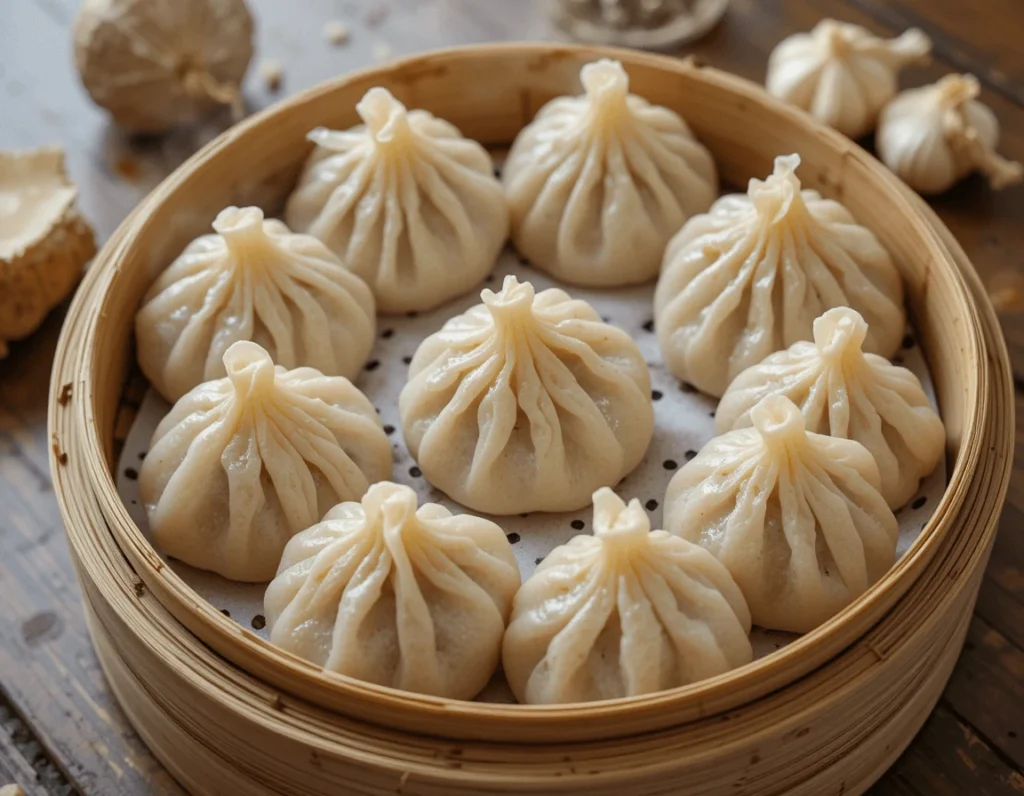
Understanding the Basics of Jiaozi
What Is a Jiaozi Dumpling?
A Jiaozi dumpling is a small dough parcel typically filled with ground meat and vegetables. The dough is thin and delicate, while the filling can range from pork to beef or even shrimp. These dumplings are versatile and can be boiled, steamed, or pan-fried.
Common Varieties of Jiaozi: Pork, Beef, and More
While pork Jiaozi is the most popular, Jiaozi can be made with various fillings. Beef, chicken, and vegetarian options are also commonly found. Pork is preferred for its rich flavor and juicy texture, which makes it the go-to choice for traditional recipes.
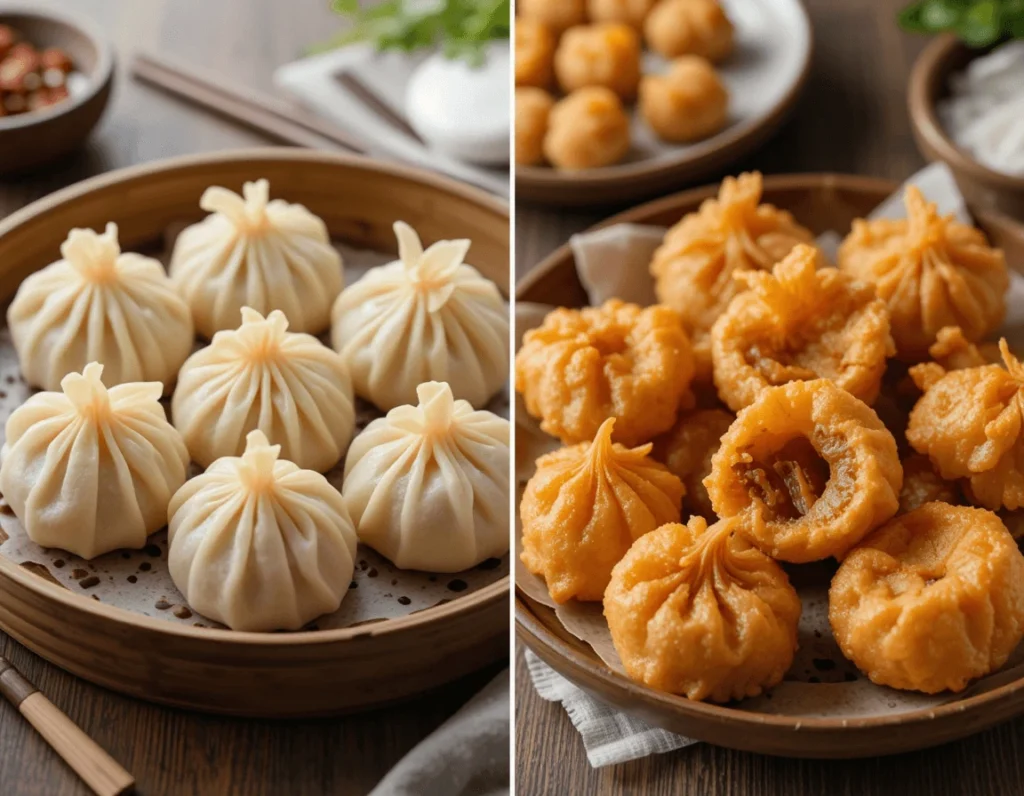
Pork Dumplings vs. Other Dumplings
What Is the Difference Between Jiaozi and Dumplings?
The term “dumpling” is broad and includes many types of stuffed dough dishes from around the world. Jiaozi is a specific type of Chinese dumpling, known for its thin wrapper and savory fillings. While other dumplings, like ravioli from Italy or pierogi from Eastern Europe, may share similarities, Jiaozi’s distinct folding style and variety of fillings set it apart.
Jiaozi vs. Potstickers: What’s the Key Distinction?
Potstickers are another popular Chinese dumpling, often confused with Jiaozi. The key difference lies in the cooking method. Jiaozi can be boiled, steamed, or pan-fried, while potstickers are pan-fried until crispy on one side and then steamed. Both share the same basic dough and fillings but are prepared differently.
Jiaozi vs. Bao: What Sets These Dumplings Apart?
While Jiaozi is typically made with a thin dough wrapper, Bao (also known as Baozi) uses a thicker, fluffier dough. Bao is usually steamed and filled with larger portions of meat or vegetables, whereas Jiaozi is smaller and more delicate. Bao is often associated with larger meals, while Jiaozi is perfect for snacking or part of a larger spread.
Key Ingredients for Pork Dumplings
Traditional Pork Filling: What Goes Inside Jiaozi?
The traditional filling for pork Jiaozi includes ground pork, cabbage, green onions, ginger, and soy sauce. Some variations also include mushrooms, garlic, or water chestnuts to add texture and flavor. The filling should be moist but not overly wet, ensuring that the dumplings hold their shape when cooked.
Vegetarian Alternatives for Jiaozi Filling
For a vegetarian version of Jiaozi, you can substitute the pork with tofu, mushrooms, and a mix of vegetables like cabbage, carrots, and spinach. Miso or soy sauce can be used to season the filling, providing a rich umami flavor without the need for meat.
Seasonings and Sauces: Enhancing the Flavor of Pork Jiaozi
To enhance the flavor of your pork Jiaozi, you can experiment with different seasonings. Popular choices include sesame oil, Chinese five-spice powder, and rice vinegar. For dipping sauces, a mix of soy sauce, rice vinegar, and a touch of chili oil is commonly used.
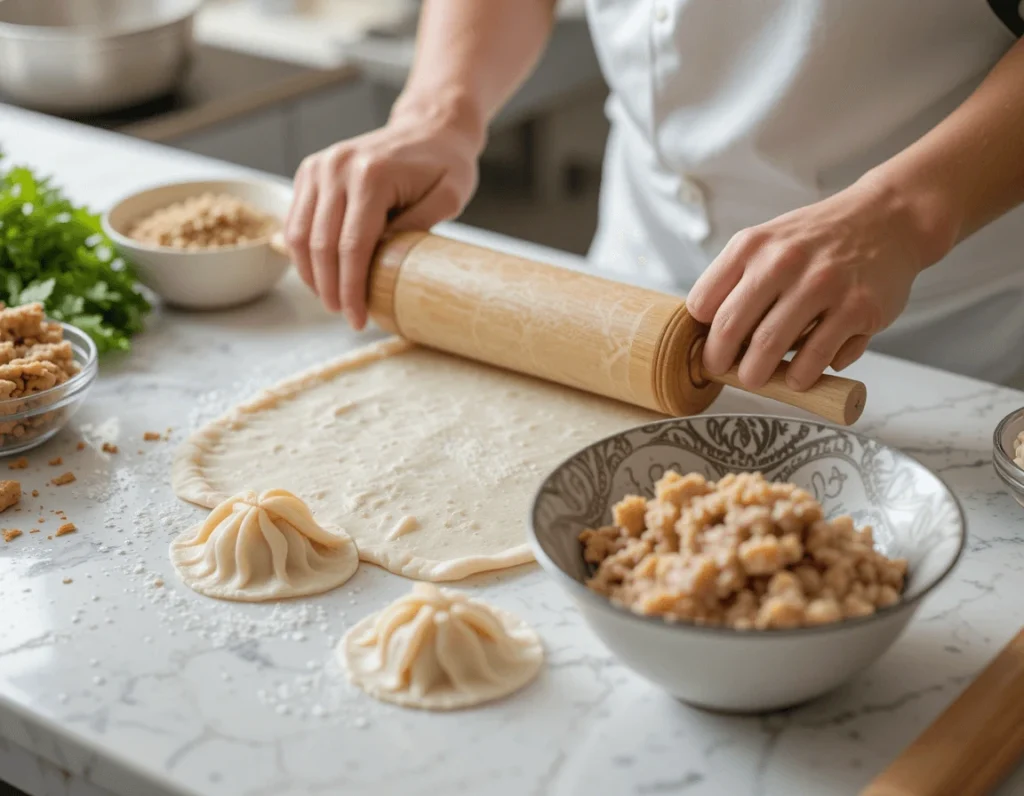
How to Make Pork Dumplings (Jiaozi) from Scratch
Step-by-Step Guide to Making Dumpling Dough
Making your own dumpling dough is a fun and rewarding process. The dough for Jiaozi should be soft but not sticky. Here is a simple recipe to follow:
| Ingredient | Quantity |
|---|---|
| All-purpose flour | 2 cups |
| Boiling water | 3/4 cup |
| Salt | 1/2 teaspoon |
- Mix the flour and salt in a bowl.
- Gradually add boiling water while stirring, until the dough begins to come together.
- Knead the dough for about 10 minutes until smooth.
- Cover with a damp cloth and let rest for 30 minutes.
How to Prepare the Perfect Pork Filling for Jiaozi
| Ingredient | Quantity |
|---|---|
| Ground pork | 1 pound |
| Cabbage | 1 cup, finely chopped |
| Green onions | 1/4 cup, chopped |
| Soy sauce | 2 tablespoons |
| Ginger | 1 teaspoon, minced |
- In a large mixing bowl, combine the pork, cabbage, green onions, soy sauce, ginger, and garlic.
- Mix well until all ingredients are evenly incorporated.
- Season with salt and pepper to taste.
Folding Techniques for the Perfect Dumpling Shape
To fold the dumplings, follow these steps:
- Roll the dough into small circles (about 3 inches in diameter).
- Place a teaspoon of filling in the center.
- Fold the dough in half to form a half-moon shape, pinching the edges tightly to seal.
- Crimp the edges to ensure a secure seal.
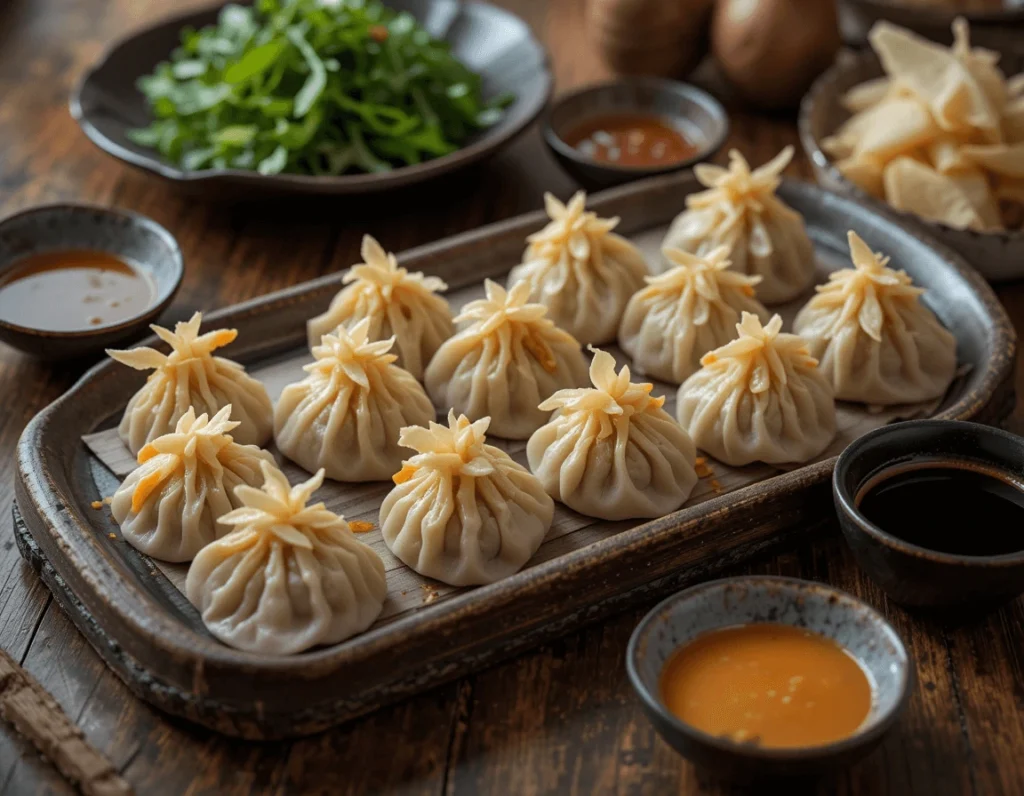
Cooking Methods for Jiaozi
How to Boil Jiaozi for the Perfect Texture
Boiling is the most common method for cooking Jiaozi. Here’s how you can do it:
- Bring a large pot of water to a boil.
- Drop the Jiaozi into the boiling water, ensuring they are not crowded.
- Stir gently to prevent sticking.
- Once the Jiaozi float to the top, continue boiling for another 3-5 minutes.
Pan-Frying Jiaozi: Achieving Crispy Bottoms
To achieve crispy bottoms, pan-fry your Jiaozi:
- Heat a tablespoon of oil in a non-stick pan.
- Place the dumplings in the pan, flat side down.
- Cook until the bottoms are golden brown (about 3-4 minutes).
- Add a small amount of water to the pan and cover. Allow the dumplings to steam for an additional 4-5 minutes.
Steaming Jiaozi: A Healthier Alternative
Steaming is a healthier way to cook Jiaozi, as it retains more of the original flavor and nutrients.
- Place the dumplings on a bamboo steamer lined with parchment paper.
- Steam for about 6-8 minutes or until the dumplings are cooked through.
Jiaozi Dipping Sauces and Sides
When enjoying Pork Dumplings (Jiaozi), it’s not just the dumplings that matter—it’s also the Jiaozi dipping sauces and accompanying sides that elevate the entire dining experience. These sauces and sides complement the savory flavors of the Pork Dumplings (Jiaozi), bringing out the perfect balance of flavor and texture in each bite. Here’s a closer look at the best sauces and side dishes to pair with your Pork Dumplings (Jiaozi).
The Best Sauces for Pork Dumplings (Jiaozi)
The ideal dipping sauce for Pork Dumplings (Jiaozi) should have a perfect blend of salty, tangy, and spicy flavors that enhance the richness of the pork filling. A classic dipping sauce for Jiaozi combines soy sauce, rice vinegar, and chili oil for an added kick.
Here’s how to make a simple yet delicious dipping sauce for your Pork Dumplings (Jiaozi):
| Ingredient | Amount |
|---|---|
| Soy sauce | 1/4 cup |
| Rice vinegar | 1 tablespoon |
| Chili oil | 1 teaspoon (optional) |
| Sesame oil | 1 teaspoon |
| Garlic (minced) | 1 clove |
To prepare, simply mix all the ingredients in a small bowl. This dipping sauce perfectly complements the tender and juicy pork inside the Pork Dumplings (Jiaozi), adding depth and flavor with every bite. You can adjust the amount of chili oil to control the spiciness, depending on your preference.
Popular Side Dishes to Pair with Pork Dumplings (Jiaozi)
Pork Dumplings (Jiaozi) are often served alongside fresh, crisp vegetables or light soups that balance out the richness of the dumplings. Here are some popular side dishes that pair wonderfully with Jiaozi:
- Stir-Fried Vegetables: A medley of crunchy vegetables like carrots, cabbage, and bell peppers sautéed in a savory sauce complements the savory filling of Pork Dumplings (Jiaozi).
- Pickled Cabbage: The tangy flavor of pickled cabbage serves as a perfect counterpoint to the richness of the Pork Dumplings (Jiaozi). The acidity of the pickles helps cleanse the palate between bites, enhancing the overall dining experience.
- Hot and Sour Soup: A bowl of hot and sour soup can be the perfect side dish to accompany Pork Dumplings (Jiaozi), as its bold and tangy flavors provide a wonderful contrast to the savory dumplings.
- Garlic Chive Pancakes: Garlic chive pancakes make a savory, crispy accompaniment to Pork Dumplings (Jiaozi). The crunchy texture of the pancakes pairs beautifully with the soft dumplings, adding an extra layer of flavor and satisfaction to your meal.
How to Serve Pork Dumplings (Jiaozi) for Special Occasions
When serving Pork Dumplings (Jiaozi) during celebrations or special occasions, presentation can elevate the entire experience. Serve your Pork Dumplings (Jiaozi) on a decorative plate, garnished with freshly chopped green onions or a sprinkle of sesame seeds for added visual appeal. Make sure to provide multiple dipping sauces so your guests can try different flavors, such as soy sauce, chili oil, or even hoisin sauce for a sweeter option.
You can also serve Pork Dumplings (Jiaozi) in a steamer basket for a more traditional look, which adds to the authenticity of the experience and keeps the dumplings warm.
Jiaozi Around the World
Chinese Jiaozi vs. Korean Mandu
While Jiaozi holds a special place in Chinese cuisine, Korean Mandu is quite similar in concept but has its own unique characteristics. The fundamental idea behind both dishes is the same: a savory filling wrapped in dough. However, there are several distinctions that make Mandu stand out in the Korean culinary tradition.
One of the key differences is size. Mandu is typically larger than Jiaozi, which gives it a more substantial bite. This size difference often results in a slightly different texture when cooked. While Jiaozi is generally enjoyed in smaller, bite-sized pieces, Mandu can sometimes be made in a larger form, making it more filling.
Another major difference is the cooking method. Jiaozi is traditionally boiled, pan-fried, or steamed, whereas Mandu is more commonly deep-fried or cooked in soups. When fried, Mandu gets a crispy texture on the outside while maintaining its tender filling on the inside, providing a contrast of textures. Mandu is also a common addition to Kimchi Jjigae (Korean kimchi stew), often served alongside or in the soup itself, making it a versatile dish in Korean cuisine.
Despite these differences, both Jiaozi and Mandu share a similar cultural role, especially during Korean New Year, where they are often eaten to bring good fortune. Both types of dumplings symbolize prosperity and health in their respective cultures.
How Other Countries Have Adapted Jiaozi
The influence of Jiaozi extends far beyond the borders of China. From Japan’s Gyoza to Mandu in Korea, and even in the U.S., Jiaozi has been embraced and adapted across cultures, each with its own interpretation of the dish. While the concept of a savory filling wrapped in dough remains universal, each country has added its own local twist to both the ingredients and cooking methods, making Jiaozi an international favorite.
- Japan’s Gyoza: Japanese Gyoza are similar to Jiaozi but are usually smaller and have a more crispy bottom due to their traditional pan-frying technique. Gyoza is often served with a dipping sauce made from soy sauce, vinegar, and chili oil, which gives it a unique kick. The filling for Gyoza is often made from a mixture of pork, cabbage, and garlic, but the seasonings can vary, adding more complexity to the flavor. These Japanese gyoza are considered an adaptation of the Chinese Jiaozi, showcasing how the dish has traveled across borders.
- Mandu in Korea: As discussed earlier, Mandu shares a lot of similarities with Jiaozi but has its own identity in Korean cuisine. In addition to deep-frying and cooking in soups, Mandu can also be steamed or boiled, and it often contains a variety of fillings, including pork, beef, kimchi, tofu, and even glass noodles (known as dangmyeon). This adaptability makes Mandu a versatile dish in Korean cooking, while still being rooted in the same traditions as Jiaozi.
- Momofuku in the U.S.: The influence of Jiaozi has even spread across the globe to the United States, where chefs like David Chang have created their own spin on this traditional dish. The Momofuku Gyoza served at Momofuku restaurants is an adaptation of the classic Jiaozi. These dumplings are pan-fried to perfection, with a flavorful filling of pork, chive, and ginger, offering an innovative take on the classic. Momofuku’s gyoza has become an iconic dish in modern American cuisine, showcasing the global fusion of traditional Jiaozi recipes with contemporary cooking techniques.
- The European Influence: Even in Europe, Jiaozi has found its way into menus, particularly in restaurants that focus on Asian fusion. Italian Ravioli and Polish Pierogi share some similarities with Jiaozi in terms of being dumplings filled with a variety of ingredients, though they differ in the types of fillings and cooking methods. While Ravioli is more often served in a sauce, and Pierogi is often boiled or pan-fried, their basic structure and concept are similar to that of Jiaozi.
The Global Popularity of Jiaozi
The popularity of Jiaozi worldwide can be attributed to its adaptability, flavor, and the universal love for dumplings. It has transcended cultural boundaries, with each region putting its own stamp on the recipe, making Jiaozi a truly global dish. Whether it’s Gyoza in Japan, Mandu in Korea, or the fusion dumplings in Western countries, the core concept of a savory filling wrapped in dough remains the same.
Jiaozi has found a place in international food culture, often served at restaurants, food festivals, and street food stalls across the world. Its versatility makes it suitable for a wide range of palates, and the dumplings are often enjoyed during family gatherings, special occasions, or simply as a comforting snack.
As the global love for dumplings continues to grow, we can only expect more adaptations of Jiaozi to emerge in the culinary world. Whether through traditional or innovative takes, Jiaozi’s place in the hearts (and stomachs) of people worldwide is firmly secured.
Learn more about other Chinese dumplings on our website, visit our dumplings recipes page.
FAQs about Pork Dumplings (Jiaozi)
What Is the Filling for Jiaozi?
The filling for traditional Jiaozi typically consists of ground pork, cabbage, ginger, and garlic. It can also include various vegetables like green onions, mushrooms, and carrots.
What Is the Difference Between Bao and Jiaozi?
Bao is made with a thicker, fluffier dough and often contains larger amounts of filling. Jiaozi, on the other hand, uses a thinner dough and is smaller in size, typically eaten in greater quantities.
What Is the Difference Between Jiaozi and Dumplings?
While Jiaozi is a specific type of Chinese dumpling, the term dumpling is broad and includes various stuffed dough dishes from different cultures.
What Is a Jiaozi Dumpling?
A Jiaozi is a Chinese dumpling filled with meat and vegetables, typically served during festivals or as a popular snack. The dumpling can be boiled, steamed, or pan-fried.
Conclusion
Pork Dumplings (Jiaozi) are not just a dish but a living tradition that carries centuries of cultural significance. The savory filling of Pork Dumplings (Jiaozi) and their delicate dough have made them a staple in Chinese cuisine, symbolizing wealth, good fortune, and the joy of sharing a meal with loved ones. Whether you’re making Pork Dumplings (Jiaozi) from scratch in your kitchen or enjoying them at a restaurant, Jiaozi always brings a sense of warmth and togetherness to any meal.
Making Pork Dumplings (Jiaozi) is a hands-on, rewarding experience. From kneading the dough to carefully crafting the filling, it offers an opportunity to connect with both history and family. The versatility of Pork Dumplings (Jiaozi) also allows you to experiment with different fillings and cooking methods, ensuring that there is always something new to discover with each batch.
In addition to their rich flavors and textures, Pork Dumplings (Jiaozi) can serve as the centerpiece of special occasions or simply as a comforting meal after a busy day. They bring joy to every table, and their significance in Chinese New Year celebrations underscores their deep-rooted cultural importance. Whether served as a snack or a full meal, Pork Dumplings (Jiaozi) have the ability to create lasting memories with every bite.
So, whether you’re trying your hand at making Pork Jiaozi for the first time or you’re a seasoned pro, don’t hesitate to get creative with the fillings, dipping sauces, and cooking methods. Share the love and history of Pork Dumplings (Jiaozi) with your family and friends, and bring a little piece of Chinese tradition into your home. With this guide, you now have the knowledge to make the perfect Pork Dumplings (Jiaozi), ensuring that every bite is as rich in flavor as it is in history.
Happy cooking, and may your Pork Dumplings (Jiaozi) always be as delicious as they are meaningful!
Discover great ideas like how to make delicious vegetarian Jiaozi on our Tasty Food Inc. Blog.

